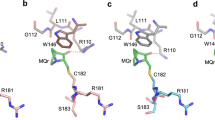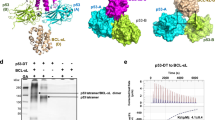Abstract
Sequence-specific DNA binding is a major activity of the tumor suppressor p53 and a prerequisite for the transactivating potential of the protein. p53 interaction with target DNA is tightly regulated by various mechanisms, including binding of different components of the transcription machinery, post-translational modifications, and interactions with other factors that modulate p53 transactivation in a cell context- and promoter-specific manner. The bi-functional redox factor 1 (Ref-1/APE1) has been identified as one of the factors, which can stimulate p53 DNA binding by redox-dependent as well as redox-independent mechanisms. Whereas stimulation of p53 DNA binding by the redox activities of Ref-1 is understood quite well, little is known about mechanisms that underlie the redox-independent effects of Ref-1. We report in this study a previously unknown activity of Ref-1 as a factor promoting tetramerization of p53. We demonstrate that Ref-1 promotes association of dimers into tetramers, and de-stacking of higher oligomeric forms into the tetrameric form in vitro, thereby enhancing p53 binding to target DNA.
This is a preview of subscription content, access via your institution
Access options
Subscribe to this journal
Receive 50 print issues and online access
$259.00 per year
only $5.18 per issue
Buy this article
- Purchase on Springer Link
- Instant access to full article PDF
Prices may be subject to local taxes which are calculated during checkout




Similar content being viewed by others
References
Appella E and Anderson CW . (2001). Eur. J. Biochem., 268, 2764–2772.
Ayed A, Mulder FAA, Yi G-S, Lu Y, Kay LE and Arrowsmith CH . (2001). Nat. Struct. Biol., 8, 756–760.
Berthold H, Scanarini M, Abney CC, Frorath B and Northemann W . (1992). Protein Exp. Purif., 3, 50–56.
Chene P . (2001). Oncogene, 20, 2611–2617.
Delphin C, Cahen P, Lawrence JJ and Baudier J . (1994). Eur. J. Biochem., 223, 683–692.
Espinosa J and Emerson B . (2001). Mol. Cell, 8, 57–69.
Fritz G, Grosch S, Tomicic M and Kaina B . (2003). Toxicology, 193, 67–78.
Gaiddon C, Moorthy NC and Prives C . (1999). EMBO J., 18, 5609–5621.
Gohler T, Reimann M, Cherny D, Walter K, Warnecke G and Kim EWD . (2002). J. Biol. Chem., 277, 41192–41203.
Hainaut P and Milner J . (1993). Cancer Res., 53, 4469–4473.
Huang P . (1998). Oncogene, 17, 261–270.
Janus F, Albrechtsen N, Knippschild U, Wiesmueller L, Grosse F and Deppert W . (1999). Mol. Cell. Biol., 19, 2155–2168.
Jayaraman L, Murthy KG, Zhu C, Curran T, Xanthoudakis S and Prives C . (1997). Genes Dev., 11, 558–570.
Johnson CR, Morin PE, Arrowsmith CH and Freire E . (1995). Biochemistry, 34, 5309–5316.
Kim E and Deppert W . (2003). Biochem. Cell Biol., 81, 141–150.
Kim E, Albrechtsen N and Deppert W . (1997). Oncogene, 15, 857–869.
Kim E, Rohaly G, Heinrichs S, Gimnopoulos D, Meibner H and Deppert W . (1999). Oncogene, 18, 7310–7318.
Mateu MG and Fersht AR . (1998). EMBO J., 17, 2748–2758.
McCoy M, Stavridi ES, Waterman JLF, Wieczorek AM, Opella SJ and Halazonetis TD . (1997). EMBO J., 16, 6230–6236.
McKinney K and Prives C . (2002). Mol. Cell. Biol., 22, 6797–6808.
Nagashima M, Shiseki M, Pedeux RM, Okamura S, Kitahama-Shiseki M, Miura K, Yokota J and Harris CC . (2003). Oncogene, 22, 343–350.
Nakamura Y . (2004). Cancer Sci., 95, 7–11.
Nicholls CD, McLure KG, Shields MA and Lee PWK . (2002). J. Biol. Chem., 277, 12937–12945.
Nourani A, Howe L, Pray-Grant MG, Workman JL, Grant PA and Cote J . (2003). J. Biol. Chem., 278, 19171–19175.
Oda K, Arakawa H, Tanaka T, Matsuda K, Tanikawa C, Mori T, Nishimori H, Tamai K, Tokino T, Nakamura Y and Taya Y . (2000). Cell, 102, 849–862.
Rainwater R, Parks D, Anderson ME, Tegtmeyer P and Mann K . (1995). Mol. Cell. Biol., 15, 3892–3903.
Tan Z, Sankar R, Tu W, Shin D, Liu H, Wasterlain CG and Schreiber SS . (2002). Brain Res., 929, 129–138.
Tom S, Ranalli TA, Podust VN and Bambara RA . (2001). J. Biol. Chem., 276, 48781–48789.
Ueno M, Masutani H, Arai RJ, Yamauchi A, Hirota K, Sakai T, Inamoto T, Yamaoka Y, Yodoi J and Nikaido T . (1999). J. Biol. Chem., 274, 35809–35815.
Vousden KH and Lu X . (2002). Nat. Rev. Cancer, 2, 594–604.
Wang Y, Schwedes JF, Parks D, Mann K and Tegtmeyer P . (1995). Mol. Cell. Biol., 15, 2157–2165.
Waterman MJF, Stavridi ES, Waterman JLF and Halazonetis TD . (1998). Nat. Genet., 19, 175–178.
Weinberg RL, Veprintsev DB and Fersht AR . (2004). J. Mol. Biol., 341, 1145–1159.
Wölcke J, Reimann M, Klumpp M, Gohler T, Kim E and Deppert W . (2003). J. Biol. Chem., 278, 32587–32595.
Xanthoudakis S and Curran T . (1992). EMBO J., 11, 653–665.
Xanthoudakis S, Miao GG and Curran T . (1994). Proc. Natl. Acad. Sci. USA, 91, 23–27.
Yakovleva T, Pramanik A, Terenius L, Ekstrom TJ and Bakalkin G . (2002). Trends Biochem. Sci., 27, 612–618.
Zhou JM, Ahn J, Wilson SH and Prives C . (2001). EMBO J., 20, 914–923.
Acknowledgements
We thank Ms Martina-Hintz-Malchow for careful preparation of the manuscript. This study was supported by Grant 10-1417-De4 from the Deutsche Krebshilfe and Grant I-478-44.13/1996 from the German–Israeli Foundation (GIF). The Heinrich-Pette-Institut is supported by the Freie und Hausestadt Hamburg and the Bundesministerium fur Gesundheit.
Author information
Authors and Affiliations
Corresponding author
Rights and permissions
About this article
Cite this article
Hanson, S., Kim, E. & Deppert, W. Redox factor 1 (Ref-1) enhances specific DNA binding of p53 by promoting p53 tetramerization. Oncogene 24, 1641–1647 (2005). https://doi.org/10.1038/sj.onc.1208351
Received:
Revised:
Accepted:
Published:
Issue Date:
DOI: https://doi.org/10.1038/sj.onc.1208351
Keywords
This article is cited by
-
Novel mechanism of base excision repair inhibition by low-dose nickel(II): interference of p53-mediated APE1 function
Molecular & Cellular Toxicology (2021)
-
APE1/Ref-1 as an emerging therapeutic target for various human diseases: phytochemical modulation of its functions
Experimental & Molecular Medicine (2014)
-
Understanding different functions of mammalian AP endonuclease (APE1) as a promising tool for cancer treatment
Cellular and Molecular Life Sciences (2010)
-
Base excision DNA repair defect in Gadd45a-deficient cells
Oncogene (2007)



